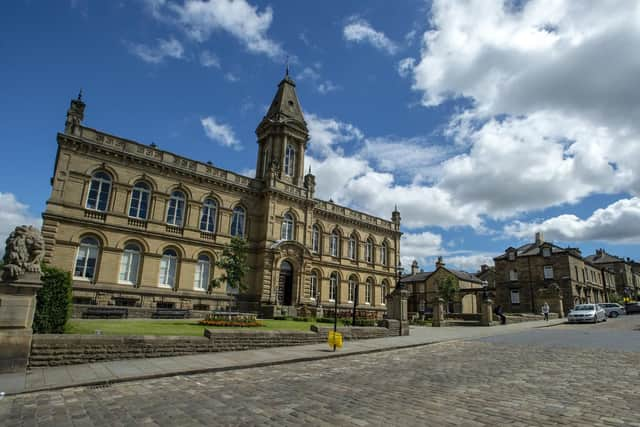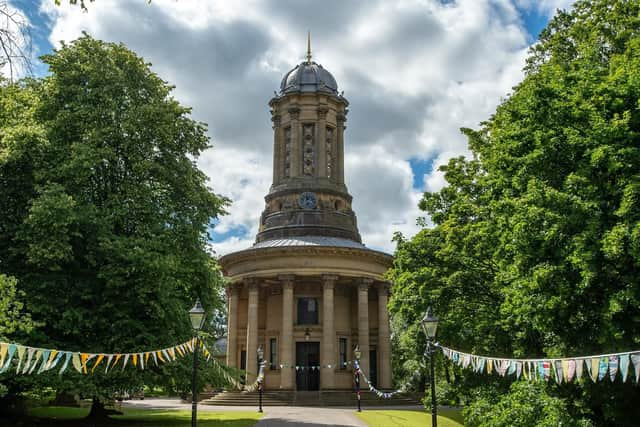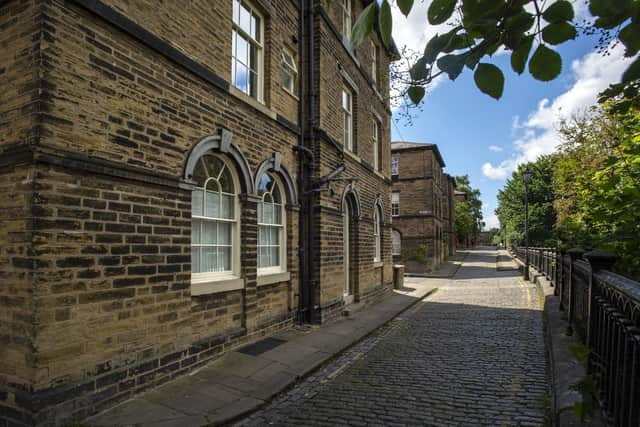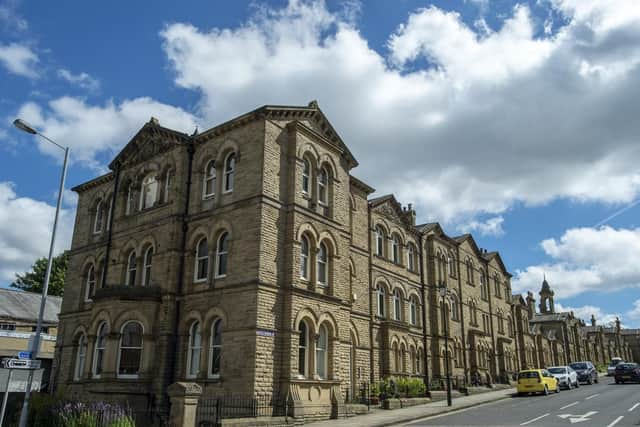Saltaire: How an industrial village became one of Yorkshire's most desirable places to live


It is the legacy of Sir Titus Salt, a Victorian wool baron with a deep interest in philanthropy. In 1851, he built his new mill in what he considered a perfect location away from the squalor and pollution of Bradford, beside the Leeds to Liverpool Canal and the railway line to Leeds and thence London.
But he wanted more than just a symbol of industrial might - he wanted a town to house his workers and improve their physical and mental wellbeing. Saltaire was born, and he built houses, an infirmary, schools and recreational facilities.
Advertisement
Hide AdAdvertisement
Hide Ad

In 1986, the mill fell silent for the final time, and the village entered a new chapter in its history. Since 2001, it has been one of Yorkshire’s two UNESCO-designated World Heritage Sites, and, more recently, has acquired somewhat of a reputation as a hipster enclave with sky-high property prices and regular appearances in TV period dramas. In 2019, Saltaire made its debut appearance in the prestigious Sunday Times Best Places to Live Guide, with writers praising its 'fun and creativity'.
A new identity in a post-industrial landscape
Maggie Smith arrived in Saltaire in 1995, and has seen the village change significantly. She now manages the Saltaire Collection, a fascinating archive of historical items.
The amateur historian and author is quick to point out that contrary to popular myth, Saltaire did not suffer a sudden socio-economic catastrophe when the mill stopped producing textiles in the 1980s. In fact, its demographics had been changing and diversifying since the 1930s, when the cottages built for Salt’s workers first began to be sold to private buyers.


Advertisement
Hide AdAdvertisement
Hide AdShe laughs when recalling her first visit to a local hairdresser, who spoke witheringly of the new Saltaire as being ‘full of teachers and social workers’ to her mostly elderly customers - not knowing that Maggie was head of children’s services for Manchester City Council at the time.
“She told me that Saltaire was ‘going down the nick’- this was around 10 years after the mill closed, when the young professionals were moving in and the village was changing.”
Stroll through Saltaire’s preserved Victorian streets today and at first glance it appears to be heaven for trendy urban creatives. There are vintage shops, galleries, artisan cafes, bars and of course Salts Mill itself, possibly the best arts and cultural space in the north.


Advertisement
Hide AdAdvertisement
Hide AdIt’s easy to assume their arrival is a recent phenomenon catalysed by the village’s excellent rail links with Leeds and Bradford. Yet somewhat surprisingly, Saltaire was at the vanguard of the early digital revolution of the 1980s, when a pioneering IT firm called Pace became one of the first tenants to move into Salts Mill after visionary Bradford businessman Jonathan Silver bought the empty building. The village became an unlikely Silicon Valley, attracting the tech nerds of the day to buy cheap terraced homes and settle near their new workplace. Pace’s successor company, Arris, still retain their Salts Mill offices and their American staff apparently love visiting Saltaire.
The local property stock hadn’t been tied to the mill in decades - Maggie points out that in 1933, the owners of Salts Mill divested themselves of the houses and shops and they went up for sale on the open market. But even in its heyday as a cradle of Salt paternalism, you didn’t have to be an employee to live in Saltaire - the houses were rented to whomever could pay.
“The Salt family’s involvement with the mill ended in 1923 and by the 1930s the business was struggling. In 1933 the bulk of the village was sold to the Bradford Property Company, who realised that old industrial housing could be improved and sold on,” explains Maggie.
Most of the workers’ cottages were two-up, two-down terraces - they attract young first-time buyers, although space constraints force many owners to move once they start families.


Advertisement
Hide AdAdvertisement
Hide Ad“Even the bigger houses that were supposed to have been built for managers of the mill could actually be rented by anybody - if you had a number of adults in the family who all worked, you could have afforded the rent.”
Saving Salts Mill - the anchor of Saltaire
In the late 1980s, Saltaire’s community was braced for a fight to save the mill from decay after production finally ceased. Salvation came in the form of Jonathan Silver, whose vision was to create a major cultural space with retail and office units. He enjoyed a good relationship with artist David Hockney, and today the gallery still houses the largest collection of original Hockney paintings in the world.
Silver died in 1997 but his family still manage the Salt estate and are continuing to develop the mill.
With the village’s focal point preserved for future generations, what next for the new Saltaire?
Advertisement
Hide AdAdvertisement
Hide AdSir Titus Salt had always been committed to the value of education, and it seemed fitting that teaching and learning filled the void of industry in the immediate post-textiles years. Many of the public buildings provided by the Salt family for their workers were taken over by Shipley College - the old staff canteen and the elementary schools among them, as well as a memorial hall.


The Saltaire Institute - a grandiose building intended for workers’ advancement, which had reading rooms, lecture halls, a library and gymnasium - is held in trust by the Salt Foundation and is now Victoria Hall, a popular wedding, events and conference venue.
The hospital, which had closed in 1979, was converted into apartments, and Roberts Park has been beautifully restored.The sports grounds are still used by cricket, tennis and bowls clubs. Only the Sunday school and public wash-house have not survived.
Advertisement
Hide AdAdvertisement
Hide AdThe original parade of shops is still thriving, even if the nature of the goods they sell has changed.
“There used to be hardware stores, milliners, butchers, clothes repair shops - the bar Don’t Tell Titus (a reference to the founder’s abstinence) used to be a greengrocer’s. The shops have changed now and they reflect the people who live here. I’ve been stopped by groups of women from coach tours asking where the ‘proper shops’ are, as if there’s going to be an M&S or Debenhams! I’m pleased they’re not just selling tourist tat,” says Maggie.
And the clubs and societies founded for the mill workers continue to thrive.
“I would say they are as strong as they were in Salt’s day. There are vibrant sports clubs, and the allotment growers’ association is now called Veg on the Edge. Back in the days of the mill, there were women’s football teams with names like the Canteen Cuties, and the football club is still going strong. There are more recent additions like the running club, Saltaire Striders.
Advertisement
Hide AdAdvertisement
Hide Ad“The Saltaire Festival is almost like a legacy of the Whitsun holidays, when the mill workers would have concerts, meals and trips out. The mill paid but these days the volunteers have to raise £60,000 to put the festival on.”
"Don't change my Saltaire"
Modern Saltaire does face challenges and conflict caused by expensive housing, gentrification and opposition to new development.
“A lot of individuals own buy-to-let houses here now. Even the smallest houses don’t sell for less than £140,000 and there is a transient side, with young professionals who rent here but can’t afford to buy, so have to look further away in Shipley or Bingley," explains Maggie.
“The estate agents have waiting lists for larger houses - mine sold within an hour of it going on the market!”
Advertisement
Hide AdAdvertisement
Hide AdLocal councillor Alex Ross-Shaw, who lives just outside the village boundary, agrees that the area has a transient population.
"There is a high turnover because the commuting links are so good - you get the classic young professional who rents for a while then moves on. But the first-time buyers are staying in the area, I know that many of the people who have bought apartments at The Exchange next to Shipley Station have moved from Saltaire. There are plenty of long-term residents too - it's a good mix."
Owners have to adhere to strict planning regulations enforced by Bradford City Council to ensure the character of the village remains in keeping with its World Heritage Site status.
“This is a rare type of community and it’s great that the council want to preserve the heritage of it - we are one of the few continuously-occupied UNESCO sites in the world,” Maggie points out.
Advertisement
Hide AdAdvertisement
Hide AdYet some take the protection of Saltaire too far, and disputes have broken out over tree felling and even the geese in the park.
When the Silver family funded a new special needs teaching area for Shipley College students - the first new building in Saltaire for over 100 years - as a memorial to Jonathan, opposition came from all over the world.
“There was a Facebook campaign and objections came from people living in the USA and Europe who’d never visited Saltaire. It got quite nasty. The site had only been home to some polytunnels before it was built on," says Maggie.
Advertisement
Hide AdAdvertisement
Hide Ad“People also complain about the college students, when in fact they’re very well-behaved and there is a security team which patrols the village. They bring a more cosmopolitan atmosphere and diversity which is important for Saltaire.”
Hundreds of people attended an emotionally-charged meeting about the proposed removal of dangerous trees on Victoria Road - despite there being much clearer views of Shipley Glen from the village centre as a consequence of the order.
“That’s the negative side of Saltaire. There are even people who want the Canada geese that Salt introduced to the park removing because of the mess they make.”
Alex is keen to assert that accessibility for people with mobility issues has improved since the trees were felled, and that they were not part of the original village layout, having been planted in the 1950s.
Advertisement
Hide AdAdvertisement
Hide Ad"People have a lot of emotive reasons for loving Saltaire, and there are a lot of debates over what period constitutes 'heritage'."
Looking to the future
Alex has lived in the area for 15 years and has witnessed community spirit grow.
"There are more shops, cafes and eateries now, but the community has also become more active for such a small place. The Festival has grown and the Christmas lights switch-on is a much bigger event now.
"We're coming up with a new travel plan for Saltaire, because it wasn't built for cars, although it's actually far more future-proof than Salt could ever have imagined.
Advertisement
Hide AdAdvertisement
Hide Ad"The quality of life here and the transport links are so good. Usage of the station has rocketed and you don't need a car to live here. We have Roberts Park, Shipley Glen and Baildon Moor on our doorstep, and a world-class art gallery."
In future, Maggie and her fellow volunteers hope to make Milner Field, the site of the great mansion built for Sir Titus Jnr, more attractive to visitors - it was demolished in the 1950s and the woodland where it stood has been threatened with development ever since.
“That is one of the few remaining areas where you can stand and look down the valley and see what Sir Titus would have seen.”
It’s thanks to the organisations and groups considered the ‘heroes’ of Saltaire that this jewel in the Aire Valley's crown has been saved and investment pledged in its future - the volunteers, the Silver family and Bradford City Council.
Advertisement
Hide AdAdvertisement
Hide AdBut to Maggie, the success of this community is best embodied by the relationship she describes between one of the few remaining elderly residents to have worked in the mills and her young, creative next-door neighbours. It is the produce from this woman’s allotment which supplies their family events - a bridging of the generations that for Maggie is the essence of Saltaire.